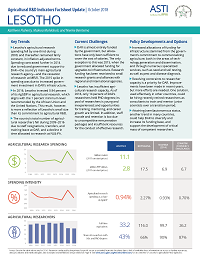Authors:
Kathleen Flaherty, Maleoa Mohloboli, and Nienke Beintema
Year:
2018
Publisher
International Food Policy Research Institute and Department of Agricultural Research
Back to:
KEY TRENDS
- Lesotho’s agricultural research spending fell by one-third during 2009, and thereafter remained fairly constant, in inflation-adjusted terms. Spending contracted further in 2014 due to reduced government support to DAR—the country’s main agricultural research agency—and the cessation of research at MFLR. The 2015 spike in funding to DAR was due to increased government investment in infrastructure.
- In 2016, Lesotho invested 0.94 percent of its AgGDP in agricultural research, which aligns with the 1 percent minimum level recommended by the African Union and the United Nations. This result, however, is more a reflection of Lesotho’s small size than its commitment to agricultural R&D.
- The country’s total number of agricultural researchers fell during 2009–2016 due to staff resignations, transfers, and training leave at DAR, and a decline in time allocated to research at NUL-FA.
CURRENT CHALLENGES
- DAR is almost entirely funded by the government, but allocations have only been sufficient to cover the cost of salaries. Research funding has been restricted to small research grants and alliances with regional and international agencies.
- Lesotho has insufficient agricultural research capacity. As of 2016, only 14 percent of DAR’s researchers held PhD degrees; its pool of researchers is young and inexperienced; and opportunities for training, mentoring, and career growth are limited. In addition, staff morale and retention is low due to uncompetitive remuneration packages and insufficient resources for the conduct of effective research.
POLICY OBSERVATIONS
- Increased allocations of funding for infrastructure stemmed from the government’s commitment to commercializing agriculture, both in the areas of technology generation and dissemination, and through numerous specialized services, such as seed testing, and pest and disease diagnosis.
- Resolving constraints to researcher capacity is a priority for DAR. Improvements have been made in recent years, but more efforts are need. One solution, used effectively in other countries, could be hiring recently retired researchers as consultants to train and mentor junior scientists over a transition period.
- Attaining (semi)autonomous status, another trend in many countries, could help DAR to diversify and increase its funding base, and support the development of critical mass of competent researchers.

